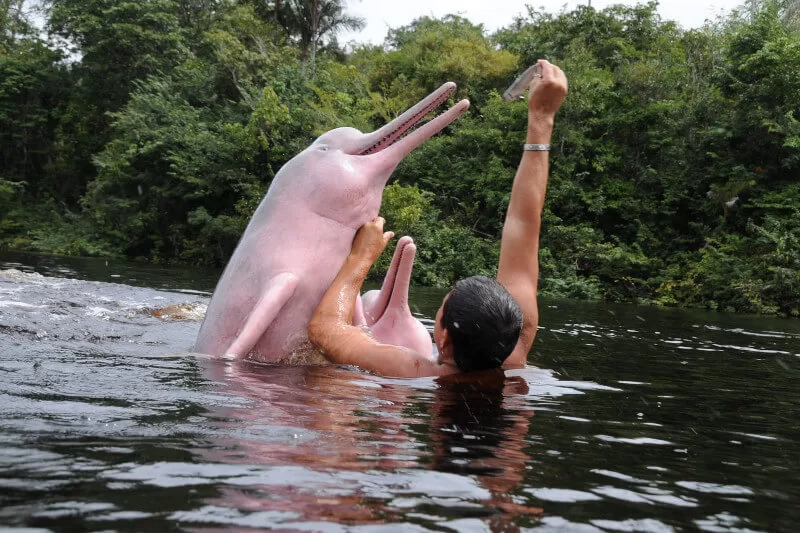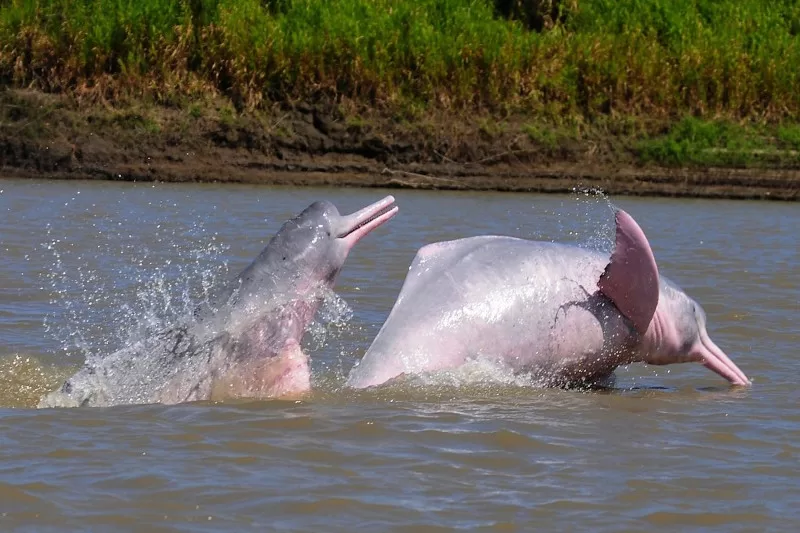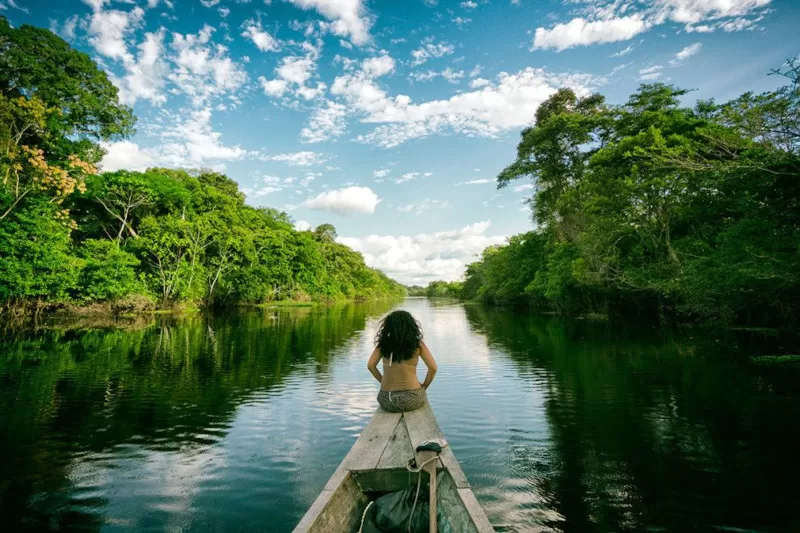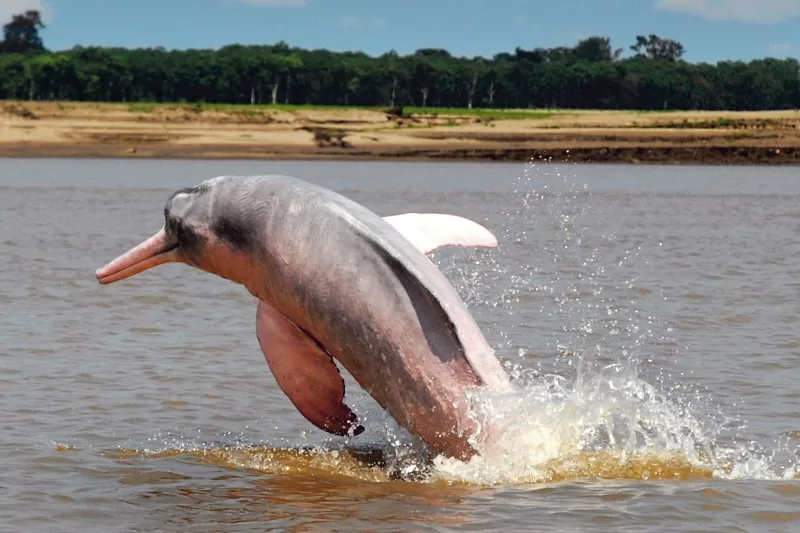The pink dolphin is a fascinating creature found in the Amazon River. This aquatic marvel captivates researchers and wildlife enthusiasts alike. Its vibrant color and unique behavior make it truly special.
Known scientifically as the Amazon river dolphin, it thrives in freshwater environments. Its distinct pink hue can change with mood and age. These dolphins play a crucial role in the Amazon ecosystem.
Exploring the life of the pink dolphin reveals its social nature. People recognize them for their intelligence and playful behavior. Understanding their habitat is vital for conservation efforts.
Threats such as pollution and habitat loss challenge their survival. Protecting the pink dolphin is essential for maintaining biodiversity. Efforts are underway to raise awareness about this unique species.

The pink dolphin stands out as one of the most intriguing creatures in the Amazon. Known scientifically , it boasts unique physical traits that captivate everyone. Its signature pink hue, which can intensify with excitement, adds to its allure.
Young pink dolphins start life as a gray color. As they age, they gradually turn pink, often revealing vibrant shades. Various factors, including mood and water temperature, influence this transformation.
These dolphins possess a remarkable adaptability to their environment. They thrive in the complex river basin of the Amazon, navigating through winding waterways. Their flexible bodies allow them to maneuver easily in shallow waters.
Pink dolphins exhibit exceptional intelligence and social behavior. They often engage in playful activities, showcasing their curious nature. Observing them interact in their natural habitat provides a unique wildlife experience.

The pink dolphin features a long, slender body that can reach up to 8.5 feet in length. Its beak is elongated, allowing it to catch fish with ease. This design makes the pink dolphin an efficient hunter in murky waters.
Their skin appears smooth and hairless, contributing to their streamlined shape. This smooth surface aids in reducing drag while swimming. Additionally, their unique dorsal fin, which is smaller than that of other dolphins, adds to their distinctiveness.
Another fascinating aspect is their echolocation ability. Pink dolphins use sound waves to navigate and find prey in dark waters. This skill makes them adept hunters, even in challenging environments.
Pink dolphins are social animals that often travel in groups called pods. These pods can consist of a few individuals or larger gatherings. They communicate through a range of clicks and whistles, establishing strong social bonds.
Their playful nature often leads them to engage in acrobatic displays. Jumping and spinning in the water, they entertain onlookers with their agility. Such behavior showcases their intelligence and reinforces social ties within the pod.
Additionally, pink dolphins exhibit nurturing behavior. Mothers care for their young with remarkable dedication. This strong maternal instinct plays a vital role in the survival of the species.
Despite their charm, pink dolphins face numerous threats in the wild. Habitat loss due to deforestation and pollution significantly impacts their population. Efforts to raise awareness about their plight are crucial for their survival.
Fishing practices, including bycatch, also threaten these dolphins. They can become entangled in nets, leading to injury or death. Supporting sustainable fishing practices can help protect their habitat.
Conservation initiatives are underway to safeguard the pink dolphin’s future. Organizations work tirelessly to promote awareness and protect their river basin habitat. Engaging local communities is essential for successful conservation efforts.
Understanding the unique characteristics of the pink dolphin enriches our appreciation for this remarkable species. Their beauty, intelligence, and social behavior make them a vital part of the Amazon ecosystem. By advocating for their protection, we can help ensure that future generations will marvel at these incredible creatures.

The pink dolphin plays a crucial role in the Amazon ecosystem. As apex predators, they help maintain the balance of aquatic life. Their hunting behaviors regulate fish populations and promote biodiversity in their habitat.
These dolphins primarily feed on various fish species, including catfish and piranhas. By controlling the numbers of these fish, pink dolphins support the health of the entire river system. Their diet reflects the rich biodiversity present in the Amazon’s intricate waterways.
Pink dolphins also contribute to the nutrient cycle within their ecosystem. When they hunt and consume prey, they help distribute nutrients through their waste. This process enriches the river environment, benefiting both plant and animal life.
Pink dolphins exhibit complex social behaviors that further enhance their ecological role. They often live in pods, creating strong social bonds. These interactions foster cooperation when hunting and caring for young, promoting a thriving community.
The social structure of pink dolphins encourages the sharing of knowledge. Young dolphins learn essential hunting techniques from experienced members. This cultural transmission is vital for their survival and success in the wild.
Moreover, their playful nature impacts the overall ecosystem positively. Their acrobatics and social interactions engage other species, promoting a vibrant aquatic environment. This behavior enhances the health and dynamics of the entire river system.
The presence of pink dolphins serves as an important indicator of ecosystem health. Healthy dolphin populations reflect a balanced and thriving environment. When dolphin numbers decline, it signals potential problems within the ecosystem.
Researchers monitor pink dolphin populations to assess the impacts of pollution and habitat loss. Changes in their behavior or population dynamics can indicate environmental stress. This valuable information helps guide conservation efforts in the Amazon basin.
Conservation organizations focus on protecting these dolphins and their habitats. Efforts include raising awareness about the importance of the pink dolphin. By educating local communities, these organizations foster stewardship of the river ecosystem.
Despite their ecological importance, pink dolphins face significant threats. Habitat destruction from logging and agriculture reduces their living space. Pollution from industrial activities further endangers their health and survival.
Engaging local communities is crucial for effective conservation strategies. Educating residents about the pink dolphin’s role promotes sustainable practices. When communities understand the ecological importance of these dolphins, they are more likely to protect them.
Conservation initiatives also aim to reduce fishing bycatch. Sustainable fishing practices help ensure that pink dolphins can thrive in their natural habitat. Collaboration between fishermen and conservationists can lead to successful outcomes.
Understanding the role of pink dolphins in the Amazon ecosystem is essential for their protection. Their presence signifies a healthy environment and a thriving biodiversity. By supporting conservation efforts, we can help secure a future for these remarkable creatures.

Conservation efforts for the pink dolphin are crucial in the Amazon. These initiatives focus on habitat preservation and pollution reduction. By protecting the river basin, we ensure a safe environment for these remarkable creatures.
Local communities play a vital role in conservation. Education programs raise awareness about the pink dolphin’s importance. When locals understand their ecological significance, they become more invested in protection efforts.
Collaborative projects between NGOs and governments target key threats. Initiatives aim to reduce fishing bycatch and promote sustainable practices. These efforts help maintain healthy dolphin populations in their natural habitat.
Community engagement is essential for the success of conservation programs. Workshops and seminars educate residents about the pink dolphin and its ecosystem. When communities participate, they become active stewards of their environment.
Volunteers often assist in research and monitoring efforts. Citizen science programs encourage locals to document dolphin sightings and behaviors. This data helps researchers understand population dynamics and threats.
Support from international organizations also boosts local efforts. Grants and funding provide resources for conservation initiatives. These partnerships enhance the effectiveness of programs aimed at protecting the pink dolphin.
Continued advocacy is necessary to ensure lasting change. Raising awareness on social media and through campaigns helps build momentum. When people around the world support conservation, they help secure a future for the pink dolphin.
In conclusion, protecting the pink dolphin requires a collective effort. By engaging communities and fostering awareness, we can safeguard this unique aquatic treasure. Together, we can ensure that future generations will continue to marvel at the pink dolphin in the Amazon.
If you got any questions, please do not hesitate to send us a message. We reply within 24 hours!
+51 900 394 399
info@biomanuexpeditions.com
reservas@biomanuexpeditions.com
